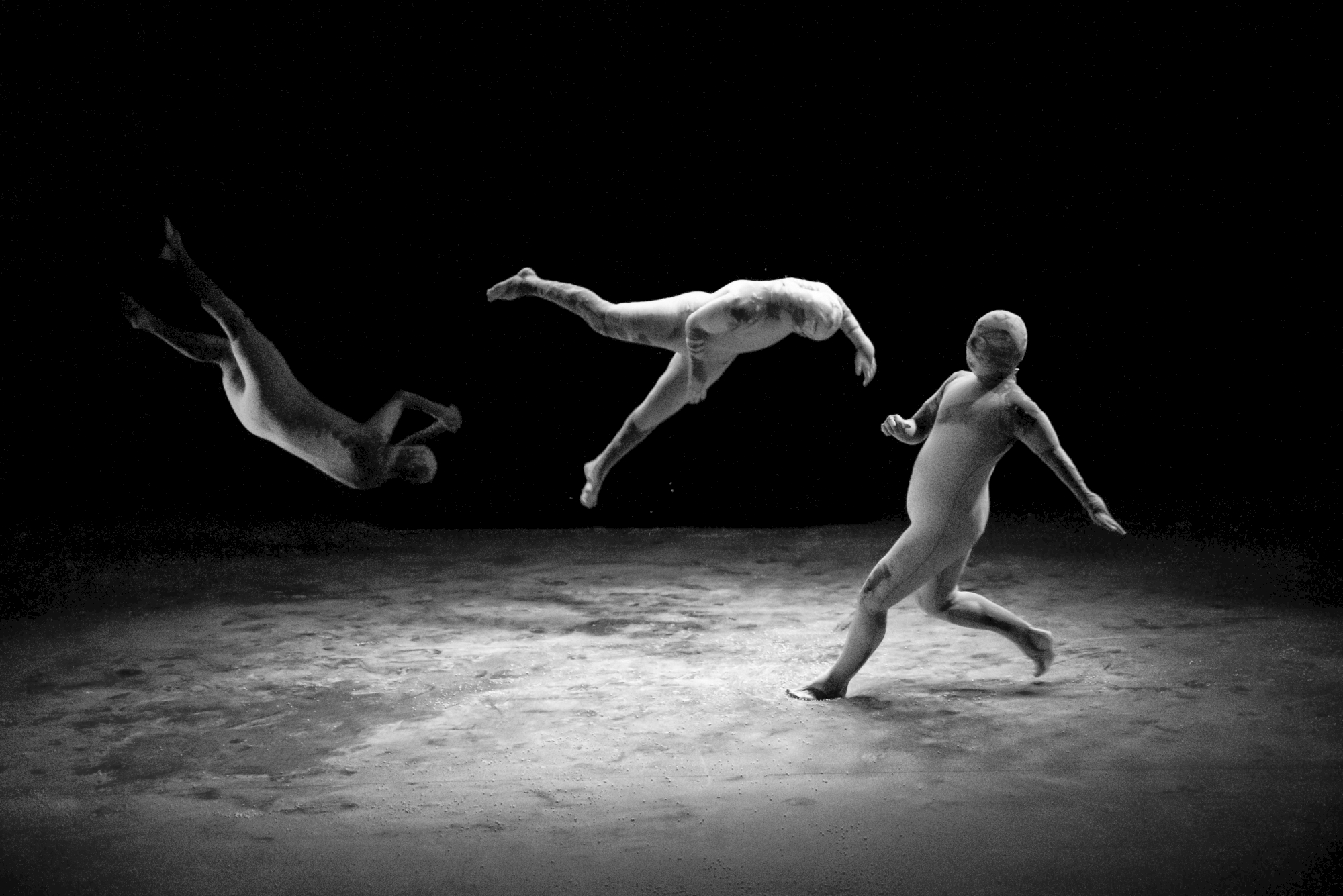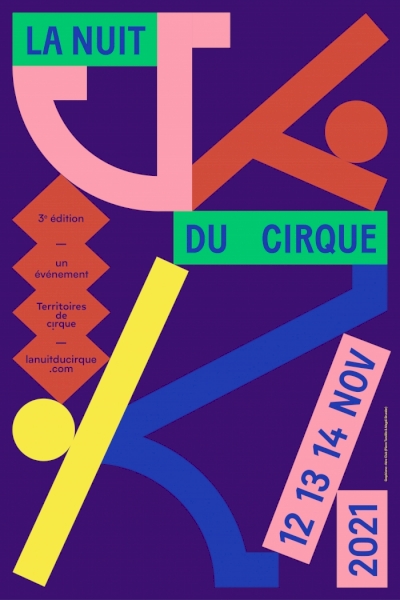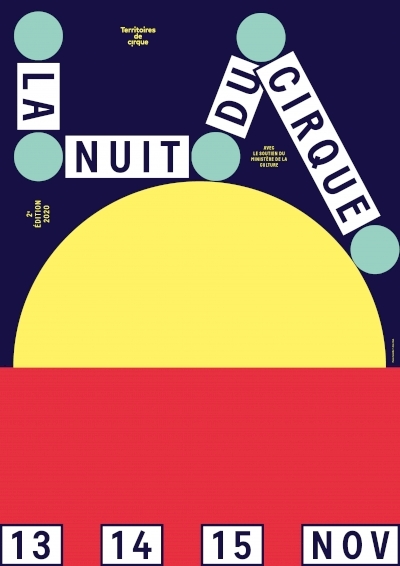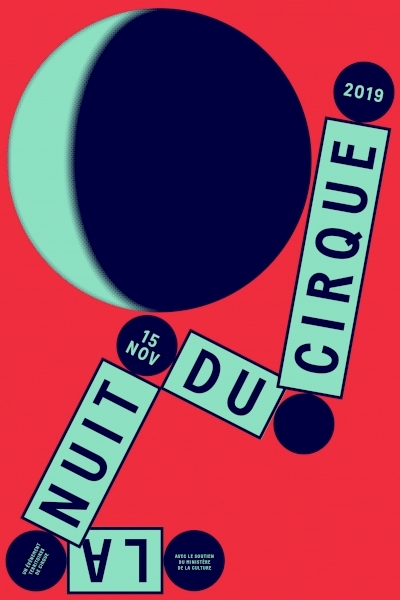
For its 4th edition, La Nuit du Cirque is embracing the theme of “À corps et à cri”, the French notion of raising a clamor with your body (corps) and your cry (cri) to make something possible. The body, the essence of the circus arts. And the cry, both a release and a message. A cry of freedom, of anger, of joy, of happiness, a cry from the heart... A circus of body that cries out, that describes, prescribes.
La Nuit du Cirque as a manifesto. A cry to escape from the consensus. A desire to affirm that the woes of the present day resonate in bodies as much as in words.
144 cultural organizations are joining forces for the 4th edition to present 214 events across France and internationally. La Nuit du Cirque is an international event organized by Territoires de Cirque with the support of the French Ministry of Culture and in collaboration with the Institut Français, Circostrada, circusnext, BUZZ (Germany), and ProCirque (Switzerland).
A WORD FROM TERRITOIRES DE CIRQUE
Interview with Philippe Le Gal
President of Territoires de Cirque
Director of the Carré Magique, national circus center in Brittany, France.
The third edition of La Nuit du Cirque in 2021 was a moment for reunions after a prolonged interruption in activities, a coming together of artists and venues and audiences. What characterizes the fourth edition of this event that is dedicated to creation in the contemporary circus arts?
Philippe Le Gal : As with related art forms, the circus is plagued by a distribution problem. Many of the shows that were created between 2020 and 2022 weren’t performed very often. Now, they’ve barely been born and they have to face competition from new and emerging works that are being created. The different stakeholders in the circus sector – the venues and artists as well as the public partners – are considering and must continue to consider how to “recover” all these shows that deserve to find their audiences. It is a good opportunity to question this permanent quest for novelty, which affects our sector as much as it does other disciplines. What about the necessary maturation period for shows where they gain in intensity and quality with each performance? What happens to the repertoire of existing works? In addition to these issues that are common to the entire performing arts sector, the circus must also face problems that are unique to the sector. For example, faced with legitimate pressure from local authorities regarding environmental sustainability, how should we think about the future of creations for the big top, which can prove to be costly in terms of energy? Not to mention the fact that the increase in fuel prices is already impacting the operating budgets of traveling shows, as the vehicle fleet consumes a great amount of energy (transporting tents, towing caravans, etc.). The circus is, therefore, in the middle of a transition that is far from finished. The 4th edition of La Nuit du Cirque will reflect this.
Will this event provide answers to these questions you have raised?
P.L.G. : Because of its open format, La Nuit du Cirque allows a wide range of venues to address the issues facing the contemporary circus in a way that reflects their own interests and passions. The format provides space to create an event on the periphery of a venue’s more traditional cultural program, to break away from the usual time frames and deadlines. The fact that, for the second year in a row, La Nuit du Cirque is spread across 72 hours encourages cultural venues to make this commitment to circus creation. This duration, as well as the total freedom granted to the venues in terms of programming, allows each site to program shows with complementary, or perhaps conflicting, aesthetics; in other words, to develop specific themes for one, two, or even three evenings. At the same time, even though it is only for a limited period, this event will make it possible to resolve some of the distribution difficulties faced by certain shows that were already rendered vulnerable by the health crisis. Having said all that, this is not a catch-up session but instead an additional window to make the greatest number of shows visible. It’s a form of short-term response to the conclusions published in the recent report from the Cour des Comptes auditors, which once again emphasized the obstacles to distributing shows of all kinds.
The title chosen for this edition of La Nuit du Cirque, “À corps et à cri”, suggests a form of resistance. Is it connected to the context you have just described?
P.L.G. : It can be interpreted this way. But above all, this title evokes the state of the circus body. The previous edition of La Nuit du Cirque showed restless bodies, still constrained and diminished by the long break from work that was imposed by the health crisis. Today, we can observe a form of liberation of this energy among circus artists, which is notably being expressed in the desire to present large-format shows with numerous performers. Because, since the beginning of the pandemic, we have noticed a proliferation of solo and duo shows. During La Nuit du Cirque, we will be able to discover the new creation by the company Ea Eo, Les Fauves, a juggling show performed under an inflatable tent. Other companies will also be presenting large works, for example, the Cirque Inextremiste in partnership with the Surnatural Orchestra, the Courcirkoui collective of balancers, or the Les 7 Doigts de la Main company... There will also be a workshop production of the latest creation from El Nucleo and the Collectif Le Petit Travers at the Agora Boulazac Aquitaine national circus center. All this will help make 2023 the year that big shows that had previously been in the works will finally hit the stage.
And what is the cry of the artists in the night?
P.L.G. : Despite the questions, despite the underlying doubts, the circus has not renounced its ability to express itself on a variety of current issues. On the contrary, the circus is going further and further in its statements, sometimes adopting forms that are similar to the theater. For example, I am thinking of La Conf’ by the Cie La Sensitive, which tackles environmental issues in an offbeat way and has met with enormous success since its creation in 2021. Martin Palisse also pushed the boundaries of narration for his autobiographical project Time to Tell, a show he worked on with the theater director David Gauchard; he will be at the Carré Magique during La Nuit du Cirque. Other artists provide an incisive look at our world without using words: with Dicklove, for example, Sandrine Juglair continues to delve into a fascinating consideration of gender that she has been carrying out for several years, while in Blanc, Sébastien Wojdan presents himself “naked”, revealing his neuroses and fragility with a fascinating movement that is utterly captivating for spectators. More broadly, and as they have always done, circus artists voice their desire to escape all categories, all classifications: with this precise “cry”, they claim their complex, singular identities.
When it was created, one of the main objectives of La Nuit du Cirque was to increase the recognition of the circus as a major art form among audiences, theaters, and public partners. Does this edition offer any interesting results in this regard?
P.L.G. : Yes, especially in 2022. Territoires de Cirque has been delighted to note that there has been an increase in requests to participate from structures whose core business is not the circus, in particular territorial organizations and the public authorities themselves. To take on circus projects, these public actors and local governments develop ways of doing things that are different from national circus centers and other specialized structures. They can also showcase different aesthetics. This is one of the great riches of La Nuit du Cirque: since it does not impose any artistic guidelines on the participating venues, it facilitates a wide range of creations that reflect the diversity of today’s circus and its capacity to think and make the world think. Not to forget that the event celebrates the poetic dimension of the circus, an aesthetic of the body itself.
This year, La Nuit du Cirque has expanded even further beyond the borders of mainland France with events in the Caribbean and other international locations.
P.L.G. : The overseas territories play an important role in La Nuit du Cirque, with a focus on Indian Ocean islands and South Africa led by Le Séchoir in Reunion Island, which Gilles Cailleau recently began to direct and which is using the event to promote the recognition of companies that are still too little known in Metropolitan France. On the opposite side of the map, Métis’Gwa, a venue in Guadeloupe that is an incubator for original artistic projects that combine circus and Caribbean culture, is taking part in La Nuit du Cirque with the same philosophy. These two structures have brought together numerous partners who are helping to define the new cartography of today’s circus and its multiple territories.
Thanks to its partnership with Circostrada and the Institut Français, La Nuit du Cirque extends beyond the borders of France. This international dynamic, which was slowed down by the Covid crisis, is reasserting itself this year. Belgium has been present since the first edition and will participate again. Poland, Germany, and Switzerland, the latter independently, joined the event in 2021. Relations with Switzerland are particularly strong thanks to close cooperation with ProCirque, especially in terms of the need to work in three languages. New countries are also joining this year: Croatia, Latvia, Ireland, Portugal, Morocco…
In addition to expanding geographically, the Nuit du Cirque is evolving in terms of the diversity of forms. This is particularly the case with the presentation of the different phases of circus creation.
P.L.G. : Alongside the finished shows, the La Nuit du Cirque program includes many works that are at different stages of completion, even more so this year than in previous years. It seems to me that this corresponds to a current trend, which arises from an interest that is common to both artists and audiences: the need to open up the creative process, to make it a space for sharing rather than a space where the creator withdraws into his or her own bubble. This is consistent, I think, with the growing importance given in the circus world to the notion of “cultural rights”. By drawing back the curtain on their creative process, circus artists provide keys to understanding their work and, contrary to what might be expected, this does not deprive audiences of the pleasure of surprise. And the regular exchange with audiences nourishes the creative work, allows for readjustments, if necessary, creates bonds, and eliminates distances. The audience shares in the process and gets an understanding of its own importance, without, of course, having the power of the final cut. An audience is no longer considered as the simple recipient of a creative work.
The presence of circus schools among the event’s partners also contributes to the openness you describe.
P.L.G. : Several of the members of the Territoires de Cirque network have circus schools. It was therefore logical for us to include them in La Nuit du Cirque, especially since amateur performances represent an important part of the circus scene. The workshops and other activities offered by La Grainerie in Toulouse, La Batoude in Beauvais, or the École Nationale de Cirque de Châtellerault, are equally important pieces of the great puzzle that is La Nuit du Cirque, just like they are part of the even greater puzzle that is the universe of the contemporary circus.
Other venues create their own events for La Nuit du Cirque, which are other pieces of the puzzle. Why are they important to the Territoires de Cirque?
P.L.G. : To cite one example, there is the anniversary of the company Les Nouveaux Nez at La Cascade, the national circus center in Bourg-Saint-Andéol in the Ardeche department. By deciding to celebrate their 31 years of existence at this moment, Alain Reynaud and the Etablissements Félix Tampon, which he manages, have, in a way, enshrined La Nuit du Cirque in the history of this artistic field. As a long-standing company dedicated to the new circus, it shares its historic legitimacy with La Nuit du Cirque. At Le Séchoir in Reunion Island, we will celebrate another anniversary, the 15th anniversary of a company that we have not seen enough of in France: Cirquons Flex. Other venues have offered a carte blanche to artists they work closely with. This is notably the case with the Agora Boulazac Aquitaine national circus center and the La Grainerie circus arts center in Balma.
In addition to being a space for distribution, La Nuit du Cirque is also an unprecedented moment for creation and invention.
Interview by Anaïs Heluin
THE NUIT DU CIRQUE TEAM
Secretary General of the Territoires de Cirque
Editorial director and coordinator of La Nuit du Cirque
Delphine Poueymidanet
Assisted by
Sophie Raoult, Nos publics
Graphic design
Pierre Tandille et Magali Brueder, Aéro Club
Website (design and code)
Salomé Macquet
Web communication
Annelise Guitet
National media relations
Carine Mangou
in collaboration with
Virginie Ferrere et Guillaume Alberny
Translation Jeremy Mercer
Journalist Anaïs Héluin


